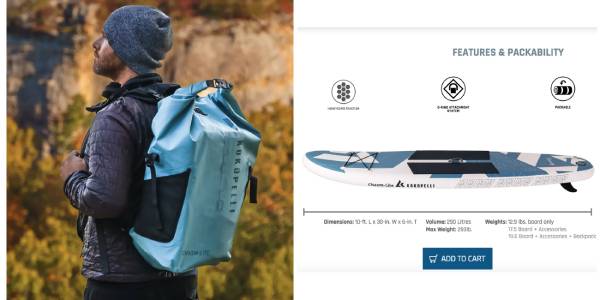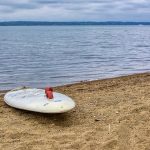It is essential to have the appropriate board when surfing. Boards vary in design- some can provide a swift ride, while others have been specifically crafted to ensure balance in large swells.
Owning the perfect surfboard will make it a breeze to capture waves. By honing your surfing abilities, you’ll have greater joy out in the surf. What criteria should be used to pick the right option? It’s simple!
Continue reading in order to find out how to pick a surfboard that is ideal for you…
choosing the right surfboard for beginners
Types of Surfboards
First lets have a look at the type of surfboards…
Longboard Surfboards
Longboards differ from short boards and skimboards in terms of their specific characteristics. Longboarding is typically seen as a slower and more laborious method of riding a board, similar to how the sport of surfing was first enjoyed.
The skaters tend to rely less on their feet for balance on the skateboard and more on their overall body weight, making it ideal for people who need an extra boost or just prefer the easier option.
In general, longboard surfers typically take on various forms of waves, such as fast, hollow, and steep rights; they may also search for lopeds that are flat- faced and roll along more gradually, giving them plenty of time to move up the wave.
You should take into account your weight before deciding which longboard to buy because there are several variations which may suit you better.
An average man weighs approximately 176 pounds, whereas the typical woman weighs 126 pounds. If you are a smaller rider, look into getting a surfboard that is between 24 and 28 inches; if you are heavier, then look into getting a bigger one, in the range of 30 to 36 inches.
The length and width of the board will affect how it fits to your feet, how it performs in different weather, how much speed it can generate, and more.
Midsize Surfboards or Funboards
These boards can navigate waves between two and four feet high easily and stylishly, not being either too heavy or too light.
They’re also great for surfers who are between beginner and expert levels looking to attempt more challenging (and steeper) places to surf, and also ideal for ladies who want a dependable board without compromising on its abilities.
Funboards
This surfing board is ideal for having a blast in waves of medium size. Generally Midsize Surfboards and these boards have similar sizes, however, these boards have greater width and thickness granting them extra buoyancy and solidity when in the water.
This permits you to effortlessly take advantage of smaller swells and practice your maneuvers without feeling like crashing is going to happen any time soon.
Don’t be fooled by their proportions – these surfboards are exclusively for more experienced surfers who have accomplished the skill of riding shortboards and seek a somewhat lengthier board for added momentum in maneuvers.
Hybrid Surfboards
Hybrid surfboards are high performance boards. These boards are quite versatile and can accommodate anything from tiny to moderate waves.
The construction of the boards make them simple to paddle and catch waves, and they make sure that riders have balanced stability.
Hybrid surfboards are typically shorter than regular longboards, which makes them more manageable to control.
Groveler Surfboards
Groveler Surfboards are fantastic for those just starting out as well as those with more experience. These boards give a lot of steadiness, yet at the same time have features that make it easy for riders to grab waves, even when the swell is big.
Those who are prone to groveling have surf boards with flat bottoms and tiny tails that make it easy to lie on your stomach and paddle into a wave.
When learning to surf, this is the way to paddle for an organic feel.
Fish Surfboards
Fish Surfboards are suitable for use on any size of wave, no matter how big or small. They give a lot of balance while being simple to paddle into the wave face when lying either face down or on your back.
Fish boards are usually not very long and they are quite broad, making them ideal for those who are either just starting out or have a bit more experience. These bikes are also simple to maneuver, which makes them an ideal selection for experienced cyclists.
Shortboards
Surfers who have more experience and want to cut down the time required to capture waves should use a shortboard.
These boards are slimmer and lighter than the others, which allows them to be more agile in the liquid.
Shortboards are ideal for smaller, quicker waves, and can still be used for other types of waves. Those who lack mastery of the sport of surfing should stay away from shortboards, as they are less forgiving than other types of boards.
Step Up Boards
Switch to STEP UP SURFBOARDS for more buoyancy with a lessened burden. These boards are ideal for riders who are just starting out or already have some experience, and guarantee an extraordinary experience.
These boards are usually constructed using either polyurethane foam or epoxy, so they can easily manage any wave. If you’ve been primarily using hard boards for surfing, the plush feel makes these an ideal alternative. As the size of the waves increases annually, it would be beneficial to have one of these pieces of equipment beneath you!
Gun Boards
Surfboards made by Gun are great for those who are looking to perform more straightforward longboarding moves. Have a problem free experience during flat water or small waves because of how fast they can get up to speed from surf breaks.
As well as how tall the semi-rigid wing sticks out over the surfer’s head, which makes it simpler to stay balanced and perform skyward stunts.
You won’t be able to catch waves as easily in return for having more control in big and powerful surf. If you need something that can do a bit of everything, then a hybrid might be the right pick for you!
Choosing the Right Size
Surfboard Volume
If you are planning to make surfing a pastime, it is essential that you learn how to pick the correct dimensions of a surfboard before starting. This will not just facilitate proper technique, but will also result in excellent equilibrium on the board.
A surfboard of greater length, around seven feet, is essential for those who have not previously surfed. The weight capacity of these boards typically accommodate persons who are between 120-160 pounds.
If someone’s outside the measurements of the standard size boards, they could choose an 8 foot option should they desire moderate paddling speed. The width of this board at its tail is 21 inches, and it narrows to 16 inches at the midpoint.
People who are deciding on a surfboard width must take into account things like their skill level, surfing experience, and weight .
A rider’s weight should determine the width of their surfboard; the greater the mass, the wider the board. This allows for successful paddling and wave-riding due to the extra support gained from the width.
Things to consider when choosing a board
When selecting the ideal surfboard for any day, there are a few important aspects that need to be taken into account. Every one of these aspects is worthwhile to think about as it could greatly affect your surfing performance.
1. What’s your Skill Level?
As stated above, someone who is a novice in surfing may only require one quality starter surfboard to help them reach a higher skill level.
A new surfer should seek out a board that provides a lot of buoyancy and balance. This surfboard would typically stand around 7 to 8 feet tall and be about 22-23 inches wide, with a thickness of 3 inches for general use.
A board of these dimensions will give adequate buoyancy to make sure they can surf on the waves. A surfboard with a soft top is ideal for those just starting out, as it offers plenty of buoyancy and steadiness while making it safer to be in the lineup.
The combination of extra width and thickness, alongside the larger nose and wider tail, makes balancing on the wave easy due to the increased stability it gives.
Once you have the basics taken care of, you can begin investigating boards made of polyester and epoxy and tweak the board design to fit your surfing skills and the kinds of waves you like. As the days go by, you will presumably seek more progress and better results from your body.
2. What’s your Fitness Level?
Your level of physical fitness will be essential in working out which board will give you the most enjoyable surfing experience. As your endurance and muscular power grows, your rowing will become more effective. Having more powerful paddles makes it possible for you to choose a board that is not as buoyant but still provides greater maneuverability. You won’t become exhausted as fast when you paddle to your desired location/surf waves, giving you more options for optimal performance.
If you feel your stamina is inadequate, you might want to get a board that can handle a larger amount of waves. The extra flotation will make canoeing much simpler and require less exertion from you. Nevertheless, this will reduce the total efficiency of the surfboard. It is essential to come to terms with a combination of your expertise, fitness level, and proficiency with the board.
For instance, their skill in surfing might have improved in the last decade, yet their strength and endurance may have decreased.
This surfer may desire a board that is bulkier and a bit broader, so that they can build up the power to paddle fast in order to catch the waves and extend their surfing time. Despite that, the board should still give a performance that is sophisticated.
An acceptable solution may be to locate a somewhat thicker combination surfboard that has 60/40 edges. You can keep on surfing both gentler and more intense waves while still getting good maneuverability from the board. Progressively surfing while allowing for a simple paddling experience is what is required.
No. 3: Your Height and Weight
Your size will be an important factor in deciding which board is suitable for you. Many volume calculators depend heavily on the most visible elements when attempting to determine the exact volume needed for a surfboard.
However, often these calculators won’t consider anything else.
The Boardcave Board Engine offers specialized criteria, including skill level, age, desired board type, and favored wave conditions, to deliver optimum recommendations.
Height and weight will always be key factors in selecting the ideal surfboard. These elements should surely be employed as a foundation for determining the appropriate board.
The dimensions of your board will increase with the size of your body. Taller surfers will require longer boards and vice versa. A good point to begin with when it comes to longboards is to get one which is approximately 3ft longer than your own height.
A 5ft tall surfer should opt for a 8ft longboard, while a 6ft tall surfer should go for the 9ft longboard if they are looking at the same type of boards. Still, every surfboard varies, and there is no steadfast regulation, though this can provide an indication of how height affects the size of the board.
No. 4: Your Wave Type
At last, here is an inquiry that is more intimate. Which wave-type do you like to surf? The primary cause that surfers possess an array of boards is because of this. The variety of waves and surf conditions vary greatly from beach to beach and even from day to day, and so does the type of surfboard necessary to accommodate those differences.
For a brief rundown:
- Small waves require a high volume. A longboard or fun shape is best.
- Medium waves become more specific. For a mushy medium-sized wave, you might still have a blast on a longboard, a fun shape, or a fish. For more aggressive, steeper medium-sized waves, you might want to bust out your performance or hybrid shortboard.
- For big waves, you’re going to need a step-up surfboard to handle the large conditions, and for XL-XXL waves, these styles of boards are known as ‘guns’.
If you anticipate spending a lot of time in the water, you should have a variety of boards in order to optimize your performance in variable conditions.




